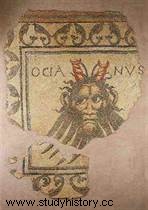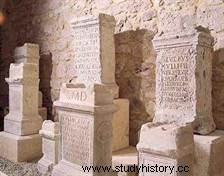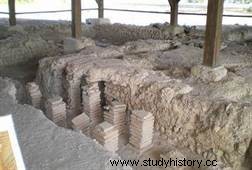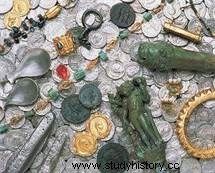 The Gers is certainly a magnificent department, famous for the products of its soil and its sweetness of life. But, heart of Gascony, it is also renowned for the qualities of courage of some of its representatives such as the famous d'Artagnan , character popularized by Alexandre Dumas, and native of Lupiac, died in the Dutch war under Louis XIV, mowed down by a cannonball. We also know the profusion of sacred buildings in the Gers, these churches and cathedrals with such a particular aspect, so much so that some are fortified. But we would like to make known here another aspect of the Gers heritage; the Gallo-Roman heritage. To do this we will invoke three different sites, particularly interesting in our opinion for the traveler-historian.
The Gers is certainly a magnificent department, famous for the products of its soil and its sweetness of life. But, heart of Gascony, it is also renowned for the qualities of courage of some of its representatives such as the famous d'Artagnan , character popularized by Alexandre Dumas, and native of Lupiac, died in the Dutch war under Louis XIV, mowed down by a cannonball. We also know the profusion of sacred buildings in the Gers, these churches and cathedrals with such a particular aspect, so much so that some are fortified. But we would like to make known here another aspect of the Gers heritage; the Gallo-Roman heritage. To do this we will invoke three different sites, particularly interesting in our opinion for the traveler-historian.
The Lectoure Museum
 First, we can start with the Lectoure Museum , east of Condom. It is located in the town hall, more precisely in the basements. This town hall itself has a certain cachet, but it should not distract anyone wishing to learn more about the surrounding ancient heritage. The visit is guided, and you have to go to the reception to then be invited to enter the vaulted cellars which spread out under the building. The setting is magnificent and gives the museum a truly intimate, almost mysterious atmosphere.
First, we can start with the Lectoure Museum , east of Condom. It is located in the town hall, more precisely in the basements. This town hall itself has a certain cachet, but it should not distract anyone wishing to learn more about the surrounding ancient heritage. The visit is guided, and you have to go to the reception to then be invited to enter the vaulted cellars which spread out under the building. The setting is magnificent and gives the museum a truly intimate, almost mysterious atmosphere.
The visit begins with a whole set of prehistoric excavation pieces , from biface to worked reindeer antlers. The showcases, although old-fashioned, are richly endowed, compared to what the modest character of the city and the museum itself would improperly suggest. But it is the sequel that interests us the most here; the next room is dedicated to the Gallic period. In particular, you can admire two heads sculpted by the Celts of the region. In different styles, they are a rare testimony because anthropomorphic representations are quite rare among the Gauls. They take place next to everyday objects, such as pottery, but also, more surprisingly, a colander.
But it is by entering the rooms dedicated to Gallo-Roman civilization that the most beautiful surprises await us. Indeed, Lectoure housed an important place of worship to Jupiter and Cybele and a very large number of inscriptions consecrating bloody sacrifices have come down to us. Individuals offered this type of offering on the occasion of religious festivals. The priest then sacrificed an animal, in this case a bull (taurobole) or a ram (cariobole) and spilled its blood. Lectoure thus has no less than 20 altars, dating from the 2nd and 3rd century AD. AD, mostly made of Pyrenean marble. At their side we can see a statue probably of Jupiter, as well as a representation of the god Mithra. But the pagan cult was not the only one represented, and sarcophagi of fine quality have come down to us. One of them is beautifully decorated with fish scales and twigs of vines, a symbol at the time of Christianity.

Continuing this decidedly surprising visit, you can discover monetary treasures, a vaulted room entirely dedicated to mosaics as well as a whole set of everyday objects in the life of Roman civilization, but how touching today. Thus a very beautiful bronze gladiator figurine takes place next to oil lamps, spoons, coins, but also a representation of a Roman boat in bone. We must also not forget the background gathering objects from the Merovingian period, donation of belt buckles and other precious jewels, bone combs.
The villa of Séviac
The interest in this small museum bodes well for our short presentation of a few representative places of daily life in the Gers almost 2000 years ago. By pushing west, after Condom, you can get to the villa of Séviac . Former home of a local aristocrat, it is a brilliant testimony to Roman architectural genius. The highlighted site allows us first of all to discover the heating system of the opulent dwellings of the Romans, namely the hypocaust system; a hearth was maintained by slaves and diffused in the ground and the walls, the heat. Indeed the slabs were placed on a kind of small pillars thus creating a space which allowed to diffuse the hot air. He could go up in the walls thanks to arranged pipes.
The house has thermal baths (Often public cleanliness and well-being establishment) where you could obviously benefit from warm, cold or hot water. The luxury of the dwellings is also noticeable in the mosaics which are numerous and well preserved. They are mostly decorated with geometric patterns and easily allow themselves trompe-l'oeil techniques. The fragile decorations are protected by roofs and sometimes also by sand, when the restoration work is not sufficiently accomplished to show it to the public without risk. The marked route is clear and leads us to enter a very rich area where history is also on the march.
 Indeed, a small private baptistery is set up in the villa and attests to the spread of Christian worship . A little away from the house, a Merovingian village was probably built after the farming estate was abandoned. On the site, in the inner courtyard, archaeologists unearthed two bodies, the lovers of Séviac, two young people who died around the 6th and 7th centuries. In a truly magnificent setting, it is therefore possible to learn and walk in the footsteps of the ancient inhabitants of the Gers. But the visit to the site continues some distance away, in the village of Montreal, where a nice little museum preserves the discoveries made in Séviac.
Indeed, a small private baptistery is set up in the villa and attests to the spread of Christian worship . A little away from the house, a Merovingian village was probably built after the farming estate was abandoned. On the site, in the inner courtyard, archaeologists unearthed two bodies, the lovers of Séviac, two young people who died around the 6th and 7th centuries. In a truly magnificent setting, it is therefore possible to learn and walk in the footsteps of the ancient inhabitants of the Gers. But the visit to the site continues some distance away, in the village of Montreal, where a nice little museum preserves the discoveries made in Séviac.
Access is free and we discover in three small rooms very beautiful pieces, such as a bust from the Roman period representing perhaps the master of the estate. There are also several mosaics put on display and therefore saved from the ravages of time. The Merovingian period is also present because we can see the iron of a francisque, a small throwing ax used by Frankish warriors. A stone column from the same period also appears in one of the windows and thus signals a form of copying by the newcomers of Gallo-Roman practices. Many small objects are also presented, such as statuettes, nails, elements of a loom, fragments of marble decorations, pieces of pipe, keys, plumb lines, rings, spoons, brooches , belt plates, pottery…
But again, these finds are associated with Paleolithic material such as carved flints, deer antlers transformed into tools... Three life-size reproductions of animals from the period are also offered to visitors, giving an idea of the local fauna of the Tertiary era. The Gers is therefore also very rich in terms of prehistory.
The Eauze Museum
 In order to continue this journey in the Ancient era, we can continue west and go to Eauze , a place that houses a treasure from the Roman era. However, here we encountered a certain disappointment. Indeed, the entrance to the museum is expensive and the visual suggests a much more commercial vocation than the previous ones. In addition, the visit is hardly up to the height of the brand new structure and the main thing is limited to a long litany of rooms aligned behind a protective window in a poorly lit and ultra-secure basement. The disappointment is less for the numismatic enthusiast who will be able to rave about the 28,000 coins update. This treasure, dating from the 3rd century, is part of a particular history of the Roman Empire; at that time barbarian bands raided the borders and sometimes penetrated deeply into the lands of Rome by plundering the country. They then returned to their territory laden with booty. Frightened civilian populations often hid real fortunes underground more because of psychosis than because of immediate danger. In this case, the buried sum could have been used to buy a small agricultural estate. This museum is therefore disappointing by the lack of diversity of its exhibition and the debauchery of visual implementation. On the other hand, if you appreciate Roman coins, do not hesitate.
In order to continue this journey in the Ancient era, we can continue west and go to Eauze , a place that houses a treasure from the Roman era. However, here we encountered a certain disappointment. Indeed, the entrance to the museum is expensive and the visual suggests a much more commercial vocation than the previous ones. In addition, the visit is hardly up to the height of the brand new structure and the main thing is limited to a long litany of rooms aligned behind a protective window in a poorly lit and ultra-secure basement. The disappointment is less for the numismatic enthusiast who will be able to rave about the 28,000 coins update. This treasure, dating from the 3rd century, is part of a particular history of the Roman Empire; at that time barbarian bands raided the borders and sometimes penetrated deeply into the lands of Rome by plundering the country. They then returned to their territory laden with booty. Frightened civilian populations often hid real fortunes underground more because of psychosis than because of immediate danger. In this case, the buried sum could have been used to buy a small agricultural estate. This museum is therefore disappointing by the lack of diversity of its exhibition and the debauchery of visual implementation. On the other hand, if you appreciate Roman coins, do not hesitate.
It is on this mixed review that we leave this short trip to the Roman Gers, hoping to have made you want to explore the ancient paths of the Gallo-Roman province. It therefore appears that the best addresses remain those which are the least visible, but which conceal a wealth much greater than that of the Eauze museum.
To go further
- Know the Gers of Georges Courtès. Editions Sud-Ouest, 2009.
- Gers by Jacques Lapart. hat, 2009.
